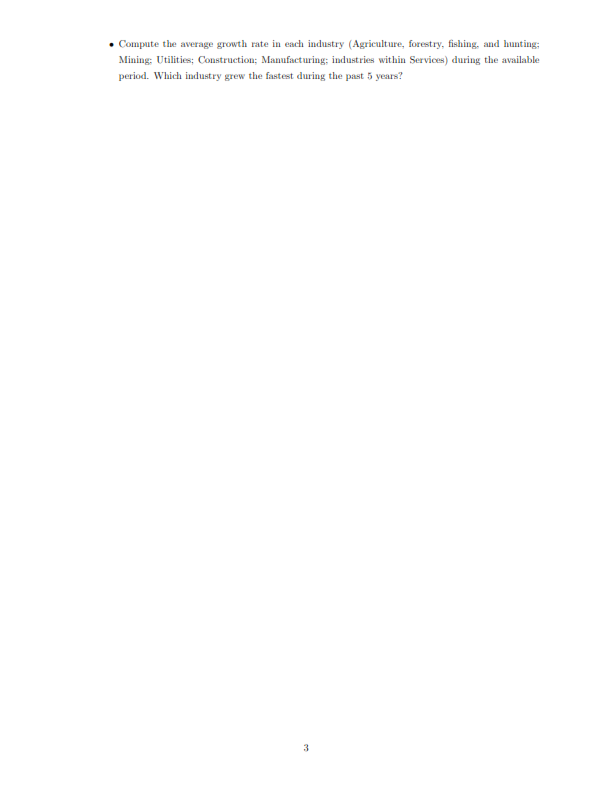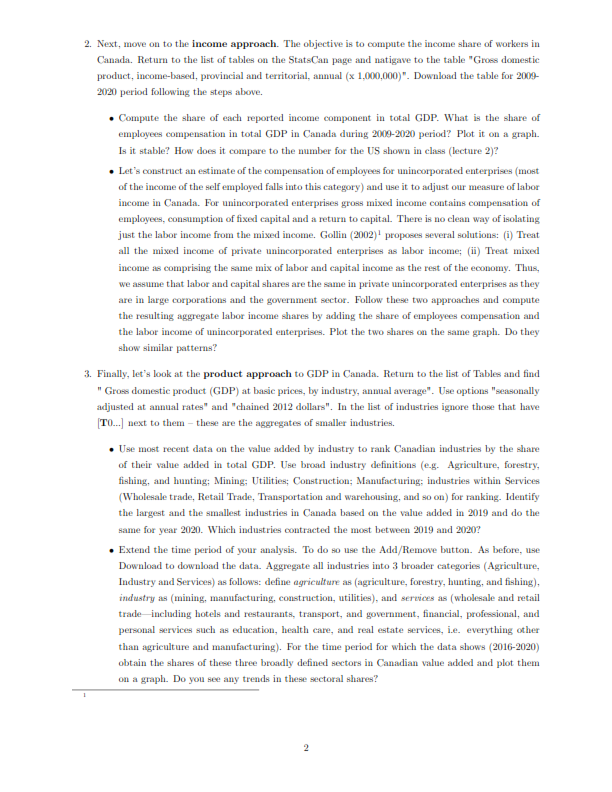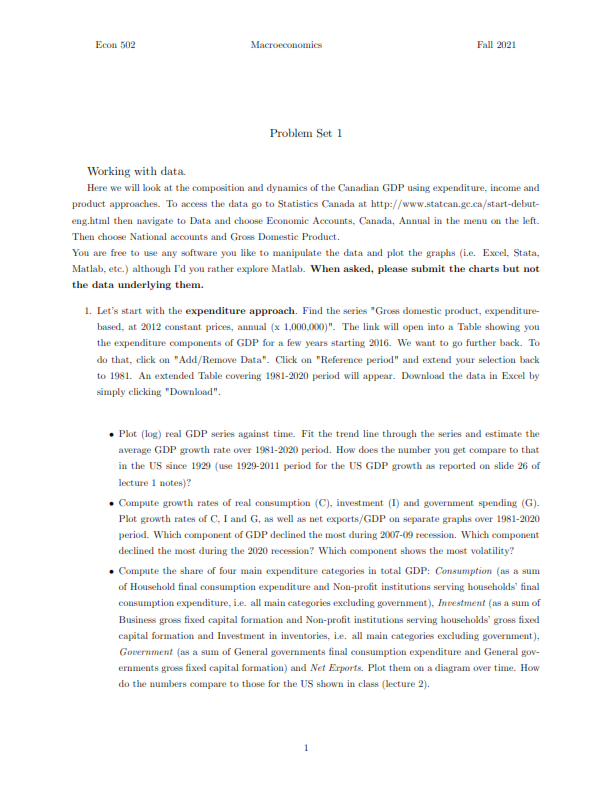Take data from this link https://www.statcan.gc.ca/eng/start
Qno 1
. Compute the average growth rate in each industry (Agriculture, forestry, fishing, and hunting; Mining: Utilities; Construction; Manufacturing; industries within Services) during the available period. Which industry grew the fastest during the past 5 years?2. Next, move on to the income approach. The objective is to compute the income share of workers in Canada. Return to the list of tables on the StatsCan page and natigave to the table "Gross domestic product, income-based, provincial and territorial, annual (x 1,000,000)". Download the table for 2009- 2020 period following the steps above. . Compute the share of each reported income component in total GDP. What is the share of employees compensation in total GDP in Canada during 2009-2020 period? Plot it on a graph. Is it stable? How does it compare to the number for the US shown in class (lecture 2)? . Let's construct an estimate of the compensation of employees for unincorporated enterprises (most of the income of the self employed falls into this category ) and use it to adjust our measure of labor income in Canada. For unincorporated enterprises gross mixed income contains compensation of employees, consumption of fixed capital and a return to capital. There is no clean way of isolating just the labor income from the mixed income. Gollin (2002) proposes several solutions: (i) Treat all the mixed income of private unincorporated enterprises as labor income; (ii) Treat mixed income as comprising the same mix of labor and capital income as the rest of the economy. Thus, we assume that labor and capital shares are the same in private unincorporated enterprises as they are in large corporations and the government sector. Follow these two approaches and compute the resulting aggregate labor income shares by adding the share of employees compensation and the labor income of unincorporated enterprises. Plot the two shares on the same graph. Do they show similar patterns? 3. Finally, let's look at the product approach to GDP in Canada. Return to the list of Tables and find " Gross domestic product (GDP) at basic prices, by industry, annual average". Use options "seasonally adjusted at annual rates" and "chained 2012 dollars". In the list of industries ignore those that have [TO..] next to them - these are the aggregates of smaller industries. . Use most recent data on the value added by industry to rank Canadian industries by the share of their value added in total GDP. Use broad industry definitions (e-g. Agriculture, forestry, fishing, and hunting; Mining; Utilities; Construction; Manufacturing; industries within Services (Wholesale trade, Retail Trade, Transportation and warehousing, and so on) for ranking. Identify the largest and the smallest industries in Canada based on the value added in 2019 and do the same for year 2020. Which industries contracted the most between 2019 and 2020? . Extend the time period of your analysis. To do so use the Add/Remove button. As before, use Download to download the data. Aggregate all industries into 3 broader categories (Agriculture, Industry and Services) as follows: define agriculture as (agriculture, forestry, hunting, and fishing). industry as (mining, manufacturing, construction, utilities), and services as ( wholesale and retail trade including hotels and restaurants, transport, and government, financial, professional, and personal services such as education, health care, and real estate services, i.e. everything other than agriculture and manufacturing). For the time period for which the data shows (2016-2020) obtain the shares of these three broadly defined sectors in Canadian value added and plot them on a graph. Do you see any trends in these sectoral shares? 2Econ 502 Macroeconomics Fall 2021 Problem Set 1 Working with data. Here we will look at the composition and dynamics of the Canadian GDP using expenditure, income and product approaches. To access the data go to Statistics Canada at http://www.statcan.gc.ca/start-debut- eng.html then navigate to Data and choose Economic Accounts, Canada, Annual in the menu on the left. Then choose National accounts and Gross Domestic Product. You are free to use any software you like to manipulate the data and plot the graphs (i.e. Excel, Stata, Matlab, etc.) although I'd you rather explore Matlab. When asked, please submit the charts but not the data underlying them. 1. Let's start with the expenditure approach. Find the series "Gross domestic product, expenditure- based, at 2012 constant prices, annual (x 1,000,000)". The link will open into a Table showing you the expenditure components of GDP for a few years starting 2016. We want to go further back. To do that, click on "Add/Remove Data". Click on "Reference period" and extend your selection back to 1981. An extended Table covering 1981-2020 period will appear. Download the data in Excel by simply clicking "Download". . Plot (log) real GDP series against time. Fit the trend line through the series and estimate the average GDP growth rate over 1981-2020 period. How does the number you get compare to that in the US since 1929 (use 1929-2011 period for the US GDP growth as reported on slide 26 of lecture 1 notes)? . Compute growth rates of real consumption (C), investment (1) and government spending (G). Plot growth rates of C, I and G, as well as net exports/GDP on separate graphs over 1981-2020 period. Which component of GDP declined the most during 2007-09 recession. Which component declined the most during the 2020 recession? Which component shows the most volatility? . Compute the share of four main expenditure categories in total GDP: Consumption (as a sum of Household final consumption expenditure and Non-profit institutions serving households' final consumption expenditure, i.e. all main categories excluding government), Investment (as a sum of Business gross fixed capital formation and Non-profit institutions serving households' gross fixed capital formation and Investment in inventories, i.e. all main categories excluding government), Government (as a sum of General governments final consumption expenditure and General gov- ernments gross fixed capital formation) and Net Exports. Plot them on a diagram over time. How do the numbers compare to those for the US shown in class (lecture 2)









